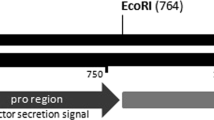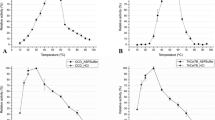Abstract
The development of cellulase production technology has greatly contributed to the successful use of cellulosic materials as renewable carbon sources. In this study, a putative endoglucanase IV (EG IV) complementary DNA was cloned from the mycelium of a strain of the filamentous fungus Trichoderma viride using a PCR-based exon-splicing method and expressed in both a silkworm BmN cell line and in silkworm larvae. Western blot analysis detected a band of 42 kDa in BmN cells after infection with a recombinant mBacmid/BmNPV/EG IV baculovirus. Sequence alignment analysis of the T. viride EG IV gene showed two domains that were highly conserved with glycosyl hydrolases and a funga-type cellulose-binding domain. Analysis of variance showed that silkworms infected with recombinant baculoviruses exhibited significantly higher enzyme activity that was 48.84% higher than silkworms infected with blank baculoviruses and 46.61% higher than normal silkworms. The expressed bioactive EG IV was also stable at the pH range from 5.0 to 10.0. The availability of large quantities of bioactive EG IV in silkworm provided a possibility to produce cellulase transgenic silkworm, which express bioactive cellulase specially in its digestive tract and improve its metabolism efficiency of mulberry leaves. Its application in the sericulture industry may be very promising.





Similar content being viewed by others

References
Aristidou, A., & Penttila, M. (2000). Metabolic engineering applications to renewable resource utilization. Current Opinion in Biotechnology, 11, 187–198.
Jeffries, T. W., & Jin, Y. S. (2002). Ethanol and thermotolerance in the bioconversion of xylose by yeasts. Advances in Applied Microbiology, 47, 221–268.
Zaldivar, J., Nielsen, J., & Olsson, L. (2001). Fuel ethanol production from lignocellulose: A challenge for metabolic engineering and process integration. Applied Microbiology and Biotechnology, 56, 17–34.
Lin, Y., & Tanaka, S. (2006). Ethanol fermentation from biomass resources: Current state and prospects. Applied Microbiology and Biotechnology, 69, 627–642.
Himmel, M. E., Ruth, M. F., & Wyman, C. E. (1999). Cellulase for commodity products from cellulosic biomass. Current Opinion in Biotechnology, 10, 358–364.
Miettinen-Oinonen, A., & Suominen, P. (2002). Enhanced production of Trichoderma reesei endoglucanases and use of the new cellulase preparations in producing the stonewashed effect on denim fabric. Applied and Environmental Microbiology, 68, 3956–3964.
Penttila, M., Lehtovaara, P., Nevalainen, H., Bhikhabhai, R., & Knowles, J. (1986). Homology between cellulase genes of Trichoderma reesei: complete nucleotide sequence of the endoglucanase I gene. Gene, 45, 253–263.
Tomme, P., Van Tilbeurgh, H., Pettersson, G., Van Damme, J., Vandekerckhove, J., Knowles, J., et al. (1988). Studies of the cellulolytic system of Trichoderma reesei QM 9414. Analysis of domain function in two cellobiohydrolases by limited proteolysis. European Journal of Biochemistry, 170, 575–581.
Wilson, D. B., & Irwin, D. C. (1999). Genetics and properties of cellulases. Advances in Biochemical Engineering/Biotechnology: Recent Progress in Bioconversion, 65, 1–21.
Watanabe, H., & Tokuda, G. (2010). Cellulolytic systems in insects. Annual Review of Entomology, 55, 609–632.
Beguin, P., & Aubert, J. P. (1984). The biological degradation of cellulose. FEMS Microbiology Reviews, 13, 25–58.
Murray, P. G., Collins, C. M., Grassick, A., & Tuohy, M. G. (2003). Molecular cloning, transcriptional, and expression analysis of the first cellulase gene (cbh2), encoding cellobiohydrolase II, from the moderately thermophilic fungus Talaromyces emersonii and structure prediction of the gene product. Biochemical and Biophysical Research Communications, 301, 280–286.
Saloheimo, M., Nakari-Setala, T., Tenkanen, M., & Penttila, M. (1997). cDNA cloning of a Trichoderma reesei cellulase and demonstration of endoglucanase activity by expression in yeast. European Journal of Biochemistry, 249, 584–591.
Wang, T. H., Liu, T., Wu, Z. H., Liu, S. L., Lu, Y., & Qu, Y. B. (2004). Novel cellulase profile of Trichoderma reesei strains constructed by cbh1 gene replacement with eg3 gene expression cassette. Acta Biochim Biophys Sin (Shanghai), 36, 667–672.
Okumura, F., Kameda, H., Ojima, T., & Hatakeyama, S. (2010). Expression of recombinant sea urchin cellulase SnEG54 using mammalian cell lines. Biochemical and Biophysical Research Communications, 395, 352–355.
van Peij, N. N., Gielkens, M. M., de Vries, R. P., Visser, J., & de Graaff, L. H. (1998). The transcriptional activator XlnR regulates both xylanolytic and endoglucanase gene expression in Aspergillus niger. Applied and Environmental Microbiology, 64, 3615–3619.
Jeefrey, L. C., & Charles, S. C. (1996) Insect cell expression technology. In: J. L. Cleland et al. (Eds.), Protein engineering, chapter 7 (pp. 183–218). New York: Wiley-Liss Press.
Maeda, S. (1994) Expression of foreign genes in insect cells using baculovirus vectors. In: K. Maramorosch, A. H. McIntosh (Ed.), Insect cell biotechnology (pp. 1–31). Boca Raton: CRC Press.
Motohashi, T., Shimojima, T., Fukagawa, T., Maenaka, K., & Park, E. Y. (2005). Efficient large-scale protein production of larvae and pupae of silkworm by Bombyx mori nuclear polyhedrosis virus bacmid system. Molecular Cell Biology Research Communications, 326, 564–569.
Choudary, P. V., Kamita, S. G., & Maeda, S. (1995). Expression of foreign genes in Bombyx mori larvae using baculovirus vectors. In C. D. Richardson (Ed.), Methods in molecular biology. Baculovirus expression protocols, vol. 39. New Jersey: Humana.
Li, X. H., Wang, D., Zhou, F., Yang, H. J., Bhaskar, R., Hu, J. B., et al. (2010). Cloning and expression of a cellulase gene in the silkworm. Bombyx mori by improved Bac-to-Bac/BmNPV baculovirus expression system. Molecular Biology Reports, 37, 3721–3728. doi:10.1007/s11033-010-0025-2.
Tang, B., Pan, H., Zhang, Q., & Ding, L. (2009). Cloning and expression of cellulase gene EG1 from Rhizopus stolonifer var. reflexus TP-02 in Escherichia coli. Bioresource Technology, 100(23), 6129–6132.
Davies, G., & Henrissat, B. (1995). Structures and mechanisms of glycosyl hydrolases. Structure, 3, 853–859.
Henrissat, B., Callebaut, I., Fabrega, S., Lehn, P., Mornon, J. P., & Davies, G. (1995). Conserved catalytic machinery and the prediction of a common fold for several families of glycosyl hydrolases. Proc Natl Acad Sci USA, 92, 7090–7094.
Mattinen, M. L., Kontteli, M., Kerovuo, J., Linder, M., Annila, A., Lindeberg, G., et al. (1997). Three-dimensional structures of three engineered cellulose-binding domains of cellobiohydrolase I from Trichoderma reesei. Protein Science, 6, 294–303.
Tomme, P., Warren, R. A., & Gilkes, N. R. (1995). Cellulose hydrolysis by bacteria and fungi. Advances in Microbial Physiology, 37, 1–81.
Zhou, X., Smith, J. A., Oi, F. M., Koehler, P. G., Bennett, G. W., & Scharf, M. E. (2007). Correlation of cellulase gene expression and cellulolytic activity throughout the gut of the termite Reticulitermes flavipes. Gene, 395, 29–39.
Shen, H., Schmuck, M., Pilz, I., Gilkes, N. R., Kilburn, D. G., Miller, R. C., et al. (1991). Deletion of the linker connecting the catalytic and cellulose-binding domains of endoglucanase A (CenA) of Cellulomonas fimi alters its conformation and catalytic activity. Journal of Biological Chemistry, 266, 11335–11340.
Zhou, L., Wu, X., Lan, L., & Liu, J. (2010). Expression of Trichoderma reesei endo-beta-glucanase II in silkworm. Bombyx mori L. by using BmNPV/Bac-to-Bac expression system and its bioactivity assay. Biotechnology Letters, 32, 67–72.
Acknowledgments
The work was supported by the National Basic Research Program of China under grand number 2012CB114601 and the National Natural Science Foundation of China (number 30972141/C120110), the Key project of Zhejiang Government (number 2011C14006), and Chinese Universities Scientific Fund.
Author information
Authors and Affiliations
Corresponding author
Rights and permissions
About this article
Cite this article
Li, Xh., Zhang, P., Liang, S. et al. Molecular Cloning and Characterization of a Putative cDNA Encoding Endoglucanase IV from Trichoderma Viride and its Expression in Bombyx Mori . Appl Biochem Biotechnol 166, 309–320 (2012). https://doi.org/10.1007/s12010-011-9426-5
Received:
Accepted:
Published:
Issue Date:
DOI: https://doi.org/10.1007/s12010-011-9426-5



